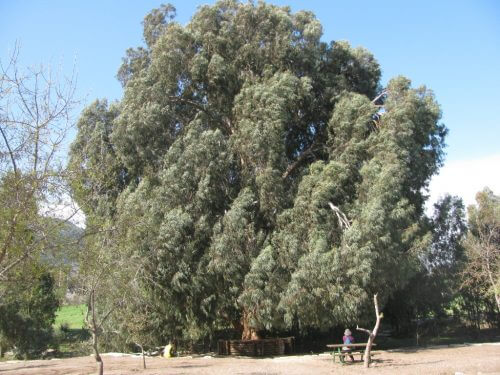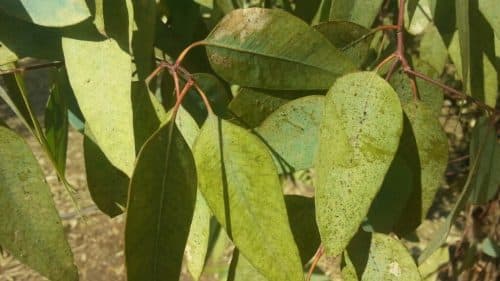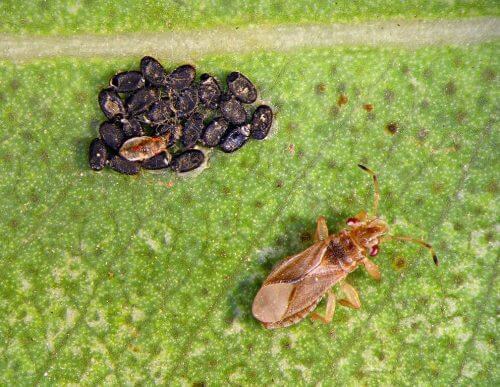A bug that came from Australia damages a tree that came from Australia and to stop it you need to import a wasp from Australia. Will we also see a jumping kangaroo here in the next phase of this ecological story?

By Alina Arbitman, Angle, Science and Environment News Agency
Eucalyptus trees, which originate in Australia, have over the years become an integral part of the Israeli landscape and culture. Poems were written about this tree, and it is considered by many to be one of the symbols of the beginning of Zionist settlement in the Land of Israel. Despite this, in recent years the authorities have begun Cut down native eucalyptus trees in moist habitats in nature reserves where it is considered an invasive species and competes with the local flora.
In the last two years, a new pest has appeared in Israel that threatens to harm eucalyptus trees: the eucalyptus bug.
The origin of the bug, known by its scientific name the bronze bug (Thaumastocoris peregrinus), also in Australia. So far the bed bug has spread in South Africa, South America and in recent years has also reached Southeast Asia and the Mediterranean basin. In Israel, the bedbug was first discovered about two years ago, in the area of the Elad settlement in the center of the country. Since then, it appears periodically, usually in spring and autumn, in the space between the interior lowlands and the coastal plain, mainly on the tops of the original eucalyptus trees (other eucalyptus species planted in Israel are less sensitive to it).
The bug feeds by sticking the stem into the leaf tissue and sucking the cell sap (the cell sap is an organ whose function is to concentrate water and solutes in the cell), which is evident in silver spots on the leaves and black dots that are the secretions of the bug. As a result, the leaves are damaged and fall off. The bug population develops rapidly, over 3-4 weeks, and can reach a peak of several millions in one eucalyptus grove.
According to Prof. Zvika Mendel, from the department of entomology (the study of insects) at the Volcani Institute, "the bed bug is also a medical nuisance, unintentionally." He explains: "The bed bug appears in very large clusters and is very small. When it penetrates the eyes or under the clothes, it is in distress, and then tries to free itself by pricking the trunk.' He also clarifies that there is difficulty in discovering the bedbug at an early stage due to its being high on the tops. "Usually when you discover it in some grove, its population has reached enormous proportions, and by the time you prepare for action, it has already moved to another grove," Mandel explains.

Wasps against bedbugs
Last spring the bug appeared in the famous Sargentim grove in Netanya. According to the ecologist of the city of Netanya, Aviv Avisher, "it caused a great danger to the residents, because it reached balconies and houses." The residents wanted the municipality to act quickly to eradicate it. After consulting with experts in the field, we came to the conclusion that the correct action is no action, and indeed, after a long period in which the trees looked bad, at the end of the season it was already possible to see their recovery. We put some of them under surveillance.'
Mandel estimates that in the long term the affected eucalyptus trees may become less aesthetic, and in some cases even degenerate. However, "understanding the interrelationship between the bug and eucalyptus will require more in-depth research," he emphasizes. Avisher has not yet observed the death of trees in the Sargentim Grove in Netanya.
The most suitable environmentally friendly solution for dealing with bedbugs is by dispersing natural enemies, in what is known as "biological control". In Australia, the country of its origin, the bed bug has many natural enemies. One of them is the parasitic wasp Cleruchoides noackae, which develops inside the bedbug eggs. Acclimating the wasp in other places has already proven itself to be an effective measure against the bed bug, among others in the countries of South America and South Africa.
Another solution, less preferred, is using pesticides that are injected into the tree and finally harm the bug that feeds on it (pesticides of this type are called systemic pesticides). According to Mandel, "this can be an interim solution, which, although it is not cheap, can be used in case of need." On the other hand, says Avisher, "there is a potential for damage in introducing poison into the trees, which remains in the system. As long as it is a temporary nuisance and no significant damage is caused to the trees, there is no justification for doing it.'

Wasp in personal import
This is not the first case where a natural enemy is imported to Israel to rescue a tree in distress. In the last ten years, parasitic wasps were brought to Israel in order to regulate the populations of several species of wasps that also damage the original eucalyptus. The harmful wasps create lesions (lesions) on the tree, which cause the leaves to fall. in research Conducted by Mendel and others, it became clear that the parasitic wasps did their job very successfully - they even left the borders of the country and were sent overseas, where they helped in the task of protecting the eucalyptus in other areas as well.
Now the eucalyptus trees are waiting to be rescued from the new pest that threatens them. The Volcani Institute hopes that the detection of the parasitic wasp that will fight the eucalyptus bug and its transfer to Israel will take place soon, and as has happened elsewhere, in Israel too it will reduce the population of the eucalyptus bug to a small and harmless density.

3 תגובות
The excessive use of systemic substances in agriculture and ornamental gardens harms beneficial insect populations and bees.
Damage to pollinating insects such as bees damages the entire plant, if they start using these substances in eucalyptus groves as well, the ecological disaster that could be caused by this may be worse than global warming.
In my opinion, as they did with DDT and Perthion, the use of these substances should be banned: Confidor Musiplan and so on.
Gan - the author is another father and not the site manager.
If you are already importing species related to eucalyptus, you can complete the series by bringing in koalas.
Maybe they will bring a wasp that will be a parasite to the wasp of the dirty ficus? (I think I made up a new name "Ficus malchalch"...)